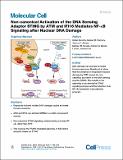Non-canonical activation of the DNA sensing adaptor STING by ATM and IFI16 mediates NF-κB signalling after nuclear DNA damage
Abstract
DNA damage can be sensed as a danger-associated molecular pattern by the innate immune system. Here we find that keratinocytes and other human cells mount an innate immune response within hours of etoposide-induced DNA damage, which involves the DNA sensing adaptor STING but is independent of the cytosolic DNA receptor cGAS. This non-canonical activation of STING is mediated by the DNA binding protein IFI16, together with the DNA damage response factors ATM and PARP-1, resulting in the assembly of an alternative STING signaling complex that includes the tumor suppressor p53 and the E3 ubiquitin ligase TRAF6. TRAF6 catalyzes the formation of K63-linked ubiquitin chains on STING, leading to the activation of the transcription factor NF-κB and the induction of an alternative STING-dependent gene expression program. We propose that STING acts as a signaling hub that coordinates a transcriptional response depending on its mode of activation.
Citation
Dunphy , G , Flannery , S M , Almine , J F , Connolly , D J , Paulus , C , Jonsson , K L , Jakobsen , M R , Nevels , M M , Bowie , A G & Unterholzner , L 2018 , ' Non-canonical activation of the DNA sensing adaptor STING by ATM and IFI16 mediates NF-κB signalling after nuclear DNA damage ' , Molecular Cell , vol. 71 , no. 5 , e5 , pp. 745-760 . https://doi.org/10.1016/j.molcel.2018.07.034
Publication
Molecular Cell
Status
Peer reviewed
ISSN
1097-2765Type
Journal article
Description
The work was supported by the Medical Research Council (Career Development Award MR/K00655X/1 to L.U. and a PhD studentship to G.D. through the MRC doctoral training program at the School of Life Sciences, University of Dundee), North West Cancer Research (project grant CR1140), and the European Commission (MC-CIG 631718). S.M.F., D.J.C., and A.G.B. were supported by Science Foundation Ireland (11/PI/1056) and the NIH (AI093752). C.P. and M.M.N. were supported by the Medical Research Council (MR/P022146/1). M.R.J. was supported by grants from the Danish Council for Independent Research, Lundbeck Foundation, and Aase og Ejnar Danielsens Fond.Collections
Items in the St Andrews Research Repository are protected by copyright, with all rights reserved, unless otherwise indicated.

